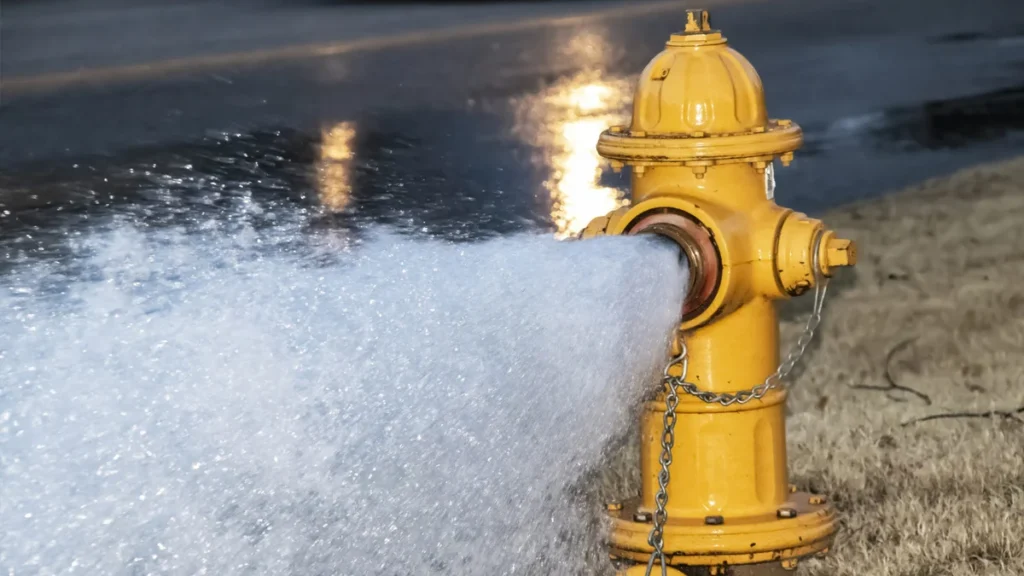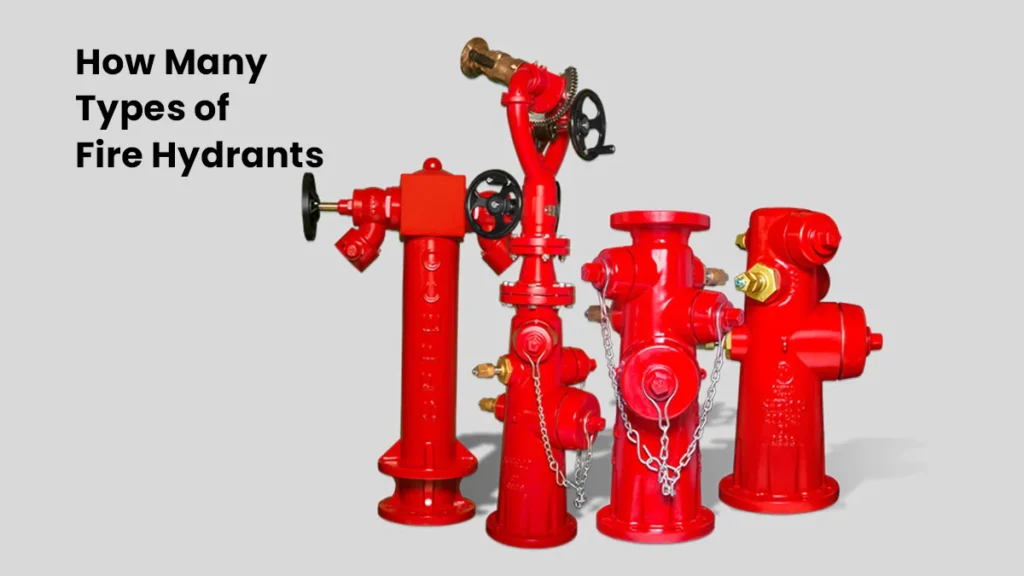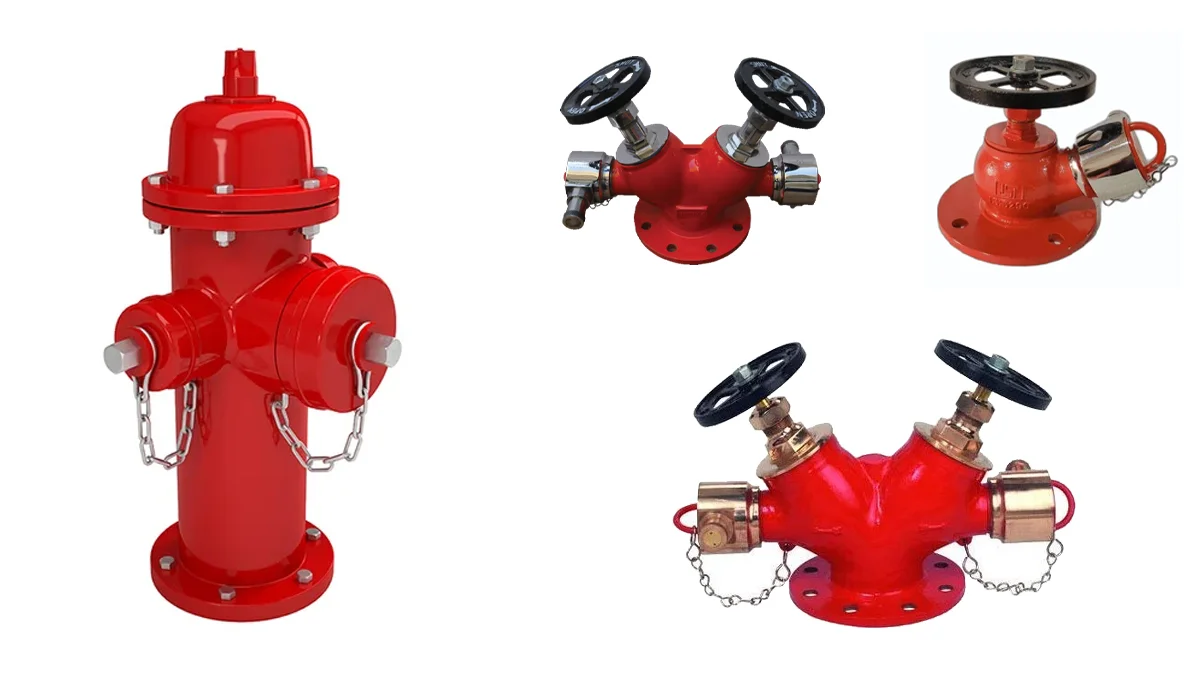A fire hydrant system plays an important role in fire protection in buildings and other infrastructure. These systems are designed to supply water to firefighters with immediate access in the event of a fire with a reliable and pressurized water source to extinguish or control fires. The types of fire hydrant systems are customized to specific requirements and depend on the size of the building, the risk level, and the available water supply. In this article, we will explore fire hydrant systems, the different types of fire hydrant systems, their components, and their appearance and color-coding.
What are fire hydrants?
Fire hydrants are essential to the smooth functioning of the city you live in. Firefighters use fire hydrants to extinguish fires. They can quickly access the water utility’s pressurized water supply thanks to fire hydrants. After removing one or two nozzles, the firefighters connect hoses to the nozzles and activate the valve to begin the water flow. Depending on the hydra’s body color and nozzle type, they can instantly identify how much pressure they have available, avoiding danger and property damage.
What are fire hydrants made of?
Fire hydrants are made from materials like cast iron, stainless steel, gunmetal, and aluminum. This is designed to be durable and resistant to corrosion.
Materials
- Cast iron: A durable material is often used for fire hydrants
- Stainless steel: A durable material is often used for fire hydrants
- Gunmetal: It is used for fire hydrants
- Aluminum: It is used for fire hydrants
Fire hydrant valves
- Fire hydrant valves are used to control the flow of water from the fire hydrant to the fire hose
- They are used to ensure that water is available during an emergency quickly and easily
Fire hydrant systems
- It is used to connect fire hoses to water pipelines in buildings
- It is used to put out medium and large fires
Fire hydrant standards
- ISI marks are allowed for fire Hydrants
- Fire hydrant valves are made according to the IS:5290 specification of BIS
What color are fire hydrants
All fire hydrants are color-coded according to NFPA guidelines. The anticipated flow during the procedure is shown by these colors. Fire hydrant top crowns are often painted. The common colors are shown in the following table according to flow.
| Color-Coding | Flow | Meaning |
| Light Blue/Blue | >1500 GPM | Very good flow, suitable for industrial applications. |
| Green | 1000-1500 GPM | good for residential purposes |
| Orange | 500-999 GPM | marginally adequate |
| Red | <500 GPM | Low flow, inadequate |
What are fire hydrants used for?

Fire hydrants are installed as part of a pipe system attached to the water supply directly. They supply water to control fires for firefighters. Water flows from the hydrant into a fire engine, where it is pumped and spread onto the fire. If the water supply is unreliable, hydrant pumps are used to pressurize the system.
A typical system like a Jockey Pump, an Electric Pump, and a Stand-by Diesel Pump. The system uses automatic pressure switches based on the pressure in the hydrant network.
The hydrant line is pressurized with water. If the pressure drops just, the jockey pump automatically fixes it. When a hydrant valve is opened to control a fire, causing an influential pressure drop, the main pump starts automatically. If there’s a power failure, the diesel pump takes over.
Firefighters connect hoses to hydrants and open valves to access water, with most hydrants delivering at least 250 gallons (950 liters) per minute. This system provides a reliable and efficient water supply during emergencies.
What is the equipment in the fire hydrant system?
An essential part of any building’s fire protection infrastructure, a fire hydrant system provides quick access to water for fighting fires. The main elements of a standard fire hydrant system are described in detail below:
Hydrant: The most familiar part of the system is the hydrant itself. The hydrant, which is usually found outdoors and has access to a pressurized supply of water, has an above-ground outlet that hoses may be connected to.
Valves: The main control valve manages the amount of water that enters the system from the main water supply. In an emergency, it is run by highly trained employees and is usually found underground.
Outlet Valves: These valves regulate the water flow through specific hoses and are found at each hydrant. To channel water to particular places, they may be opened and closed as needed.
Pipes: Water is distributed from the main supply to the hydrants through a system of underground pipelines. Usually constructed with sturdy materials like steel or ductile iron, these pipes can resist corrosion and high pressures.
Couplings: Couplings are connectors used to connect hoses to fire hydrants and other devices. To maintain water pressure when battling fires, they are made to be leak-proof and offer a safe connection.
Hose Reels: In the case of a fire, fire hoses can be quickly used thanks to these storage systems. They can be movable or fixed in place and are often found indoors around fire exits or high-risk zones.
Nozzles: Nozzles regulate the direction and flow of water and are attached to the ends of fire hoses. They are offered in many types, like solid stream nozzles for long-range applications and flexible spray nozzles for general firefighting.
Pressure Gauges: The devices used to measure the water pressure in the system are called pressure gauges. During firefighting operations, firefighters use these gauges to keep an eye on pressure levels and make sure there is a sufficient flow of water.
The Fire Department Connection (FDC): The Fire Department Connection (FDC) serves as the connection between the municipal water supply and the fire hydrant system. It increases firefighting abilities by enabling firemen to use high-pressure water mains to supplement water from the hydrant system.
How many types of fire hydrants

There are different types of Fire Hydrant Systems:
Wet Barrel Fire Hydrant System
Wet barrel fire hydrants are designed for use in places with hot or moderate climates where freezing is not an issue. A wet barrel hydrant can be identified by the fact that it continues to be filled with water. In the event of a fire, this type of technology allows faster supply of water because the water is easily accessible within the hydrant itself. The hydrant barrel is always full of water. Opening the valve will allow water to flow immediately. In warmer regions where freezing temperatures are uncommon or nonexistent, this method is often used. Water for reducing fires should be easily and quickly accessible. Fewer moving parts and a simple design. Requires less maintenance than dry barrel hydrants. In colder climates, susceptible to freezing climates, making it impractical for use in areas with freezing temperatures.
Dry Barrel Fire Hydrant System
A dry barrel fire hydrant is made for areas with freezing temperatures. In this system, water is not stored inside the hydrant. Instead, it stays in the underground pipes. The barrel stays dry until the valve is opened, letting water flow into the hydrant when needed.
This design keeps water out of the upper part of the hydrant, stopping it from freezing and causing damage. Water stays underground until required. A valve controls the water flow to the hydrant.
These hydrants are common in places with cold winters. They stop water from freezing inside the hydrant. They work well in cold climates and are more durable in freezing conditions because there’s no water in the barrel. However, they take longer to access water than wet barrel systems since the valve needs to be opened first. The design is also more complex and needs more maintenance.
Wall-Mounted Hydrant System
A wall-mounted fire hydrant system is used inside buildings to provide a fixed and accessible water source for firefighting. The hydrant is mounted on a wall, either inside or outside the building, and hoses can be attached to it to fight fires within the structure.
These hydrants are often part of an internal fire suppression system and are connected to the building’s water supply. They provide easy access to water, simplifying firefighting efforts in large buildings. This system reduces the need for external fire hydrants during an emergency.
However, the system is limited by the building’s internal water supply capacity. Regular maintenance and inspections are essential to ensure it remains functional. This makes it a practical and efficient option for fire safety in large structures.
Yard Hydrant System
A yard hydrant system is a fire hydrant installed in open areas like factory yards, warehouses, or other large outdoor spaces. It provides an external water source for firefighting in places that don’t have easy access to traditional street hydrants.
These hydrants are connected to a reliable water source, usually through underground pipes. They offer fire protection for large, open areas and are easily accessible for firefighters during outdoor emergencies. The hydrants can be strategically placed to ensure optimal coverage.
However, they can be vulnerable to damage or blockage from environmental factors such as weather or debris. Regular inspections and maintenance are necessary to keep them functional and ready for use. This system is a reliable option for fire safety in industrial and open-space settings.
Double-Outlet Fire Hydrant System
A double-outlet fire hydrant system is designed to provide two separate water outlets, making it possible to connect multiple fire hoses to a single hydrant at the same time. This system is commonly used in larger buildings, industrial complexes, and high-risk areas where a greater volume of water is essential for firefighting.
The hydrant has two separate outlets, allowing more than one hose to be used simultaneously. This capability boosts the effectiveness of firefighting efforts by supplying a higher water volume. It also provides redundancy; if one outlet is blocked or damaged, the other can still be used.
However, this system requires a strong water supply and pumping capacity to meet the higher water demand. It is an efficient and practical solution for fire protection in areas with significant fire risks and large water requirements.
Bottom Line
The systems that are connected to the water supply are the fire hydrant connections. These systems supply water so that firefighting can be done. The firefighters use a pentagonal wrench to remove the valve cover and attach the hoses so that the water may attack and quell the flames.
Fire hydrants come in different varieties like wet barrels, dry barrels, and more. Each has a distinct use. Although there is little danger of freezing in warmer climates, wet barrel fire hydrants are appropriate for those locations. The risk of water freezing makes the dry barrel fire hydrants perfect for colder climates.


